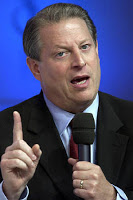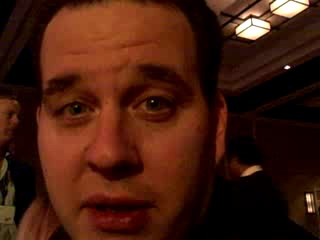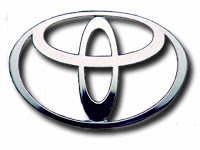He might not win another Nobel Peace Prize for it and it doesn’t rank with protecting the earth from global warming, but Al Gore may go down in history as the man who saved television advertising.
 In fact, as various cultural and technological phenomena come together – social networking, user-generated content, the convergence of Internet and television devices, and marketers’ need to reach audiences in the face of fragmentation – the former Vice President may be remembered as the man who saved television itself.
In fact, as various cultural and technological phenomena come together – social networking, user-generated content, the convergence of Internet and television devices, and marketers’ need to reach audiences in the face of fragmentation – the former Vice President may be remembered as the man who saved television itself.
A day after the Nobel committee announced its selection of Mr. Gore as co-recipient of this year’s peace prize, the former Democratic politician appeared as a central presenter at the Association of National Advertisers annual “Masters of Marketing” conference at the Arizona Biltmore near Phoenix. Mr. Gore has been a ubiquitous presence on the media and marketing conference circuit during the past several years. Most of the time, he has used the platforms to promote to these influential audiences his research and views on the dangers of climate change – the subject of his Academy Award-winning documentary An Inconvenient Truth. Indeed, just two days before his ANA appearance, he took the stage at the Google Zeitgeist conference in Mountain View, CA, to continue his campaign to influence the influencers on environmental degradation.
But at ANA, his subject was, fittingly, advertising – and how to advance it. “The fact is,” he told an audience of some 1,200 marketing, media, and agency executives, “the old format of television advertising is being questioned. A citizenry empowered with TiVo and remote controls and Internet access has called into question how long the traditional television model will deliver the service you marketers want it to perform for you.”
He made a pitch for his own cable TV network, Current TV, and the interactive properties built around. But unlike many sales pitches at this and other conferences, his resonated with a large chunk of the crowd. “We believe our model allows you, your companies, and your brands to become a part of their conversation,” Mr. Gore said.
Spots Still Prevail
The ex-Veep couldn’t have picked a better moment to address that audience. For the entire previous day, the marketers had heard speaker after speaker talk about the importance of inviting their consumers to co-create their brands with them. They heard marketing chiefs from across industries declare yet again that the era of one-way communication is dead, that advertising is now a conversation, that they had no choice but to harness interactive social media to their companies’ causes, that they had to stand for something to stand out in the cacophony of cultural conversations taking place through the Web.
For the many who had come to Phoenix from the Google conference, it was déjà vu all over again. For those who had attended IAB’s MIXX Conference in September, it was as if Jiminy Cricket was riding their shoulders whispering the same message repeatedly in their ears.
![]() Yet in each of the ANA case study presentations, the dominant format – the overwhelmingly dominant format – deployed to illustrate the “new rules” of advertising was the 30-second television spot. The audience cooed at the emotional commercials and chuckled at the funny ones. But it was difficult to spot the breakthrough format advances in anything other than the conversation.
Yet in each of the ANA case study presentations, the dominant format – the overwhelmingly dominant format – deployed to illustrate the “new rules” of advertising was the 30-second television spot. The audience cooed at the emotional commercials and chuckled at the funny ones. But it was difficult to spot the breakthrough format advances in anything other than the conversation.
It was hard to avoid the conclusion that the marketers were merely talking the talk, or, worse, acting pathologically – doing the same thing over and over again in the insane belief that it would somehow yield a different outcome.
The persistence of the one-way, 30-second spot format isn’t really surprising. A $65 billion industry, employing hundreds of thousands of people, has been built around it in the U.S.. It’s not only what so many of us know how to do; it’s what we know how to react to. At the conference, I ran into Andrew Susman, CEO of Studio One Networks, the creator and syndicator of online and off-line multimedia content, and asked him how he explained the dissonance between the calls for change and the dearth of examples. Since I was carrying a new “Flip Camera,” a lightweight, palm-sized device that can record an hour of video on its flash drive, I captured his answer.
 Marketers and agencies aren’t ignoring the disjunction between desire and action. During Google’s Zeitgeist conference and the ANA meeting, I heard no message more insistent from the agency and marketing execs than “help us change.” Hundreds of people packed the auditorium and a subsequent luncheon discussion of the joint IAB-AAAA-ANA-Booz Allen “Marketing-Media Ecosystem 2010” study, which is all about driving change across the value chain. And several signed up on the spot for the IAB’s “Interactive Boot Camp for Senior Marketers,” which we announced at the ANA meeting.
Marketers and agencies aren’t ignoring the disjunction between desire and action. During Google’s Zeitgeist conference and the ANA meeting, I heard no message more insistent from the agency and marketing execs than “help us change.” Hundreds of people packed the auditorium and a subsequent luncheon discussion of the joint IAB-AAAA-ANA-Booz Allen “Marketing-Media Ecosystem 2010” study, which is all about driving change across the value chain. And several signed up on the spot for the IAB’s “Interactive Boot Camp for Senior Marketers,” which we announced at the ANA meeting.
The Veep’s V-CAM
But among presenters, Al Gore was one of the few who offered an actual innovative path to try change in real-time – “a way of relating the Internet to television,” he said, that is more than “television sliced and diced and spit out onto the Internet,” which is how he characterized the current state of online video advertising.
Current TV is entirely premised on user-generated content, some of it socially uplifting, as befits its political provenance, and some of it purely entertaining. It’s a video aggregation site whose secret weapon is active editing and collaborative filtering.
And that’s the innovation behind its V-CAM’s – the Viewer Created Ad Messages. Yes, they are user-generated advertisements, just like those lured in (to great incumbent media attention) by Dorito’s and dozens of other brands over the past two years. But Current TV doesn’t program its V-CAM’s as high-profile one-offs. Rather, they’re built into the fabric of its Web site and its cable network, as much a part of the contextual dynamic as the user-generated documentaries. Moreover, they are constructed according to briefs drawn up by the marketers and, in many cases, their agencies. Current even provides graphic and bumper material to assure the spots are brand-compliant.
And its V-CAM’s are “socially filtered,” as Mr. Gore put it, “by real live human beings,” before being put online for judging by the community of viewers. This assures their marketer friendliness. Although the former Veep says the network has yet to receive a negative ad for any of V-CAM advertisers (a roster that includes Toyota, L’Oreal, Mountain Dew, and several others), he made a cogent case that marketers harm themselves more by that fearfulness than they ever would be by their openness. “It’s not as if it’s completely safe to continue with the cluttered model we currently have, with all the consumer resistance built into it,” he told ANA President and CEO Bob Liodice during the question-and-answer period.
For much of the past two years, I’ve been seeing increasing evidence that active editing and programming are meeting social media in a new blend, one that provides protection for nervous advertisers while still allowing the power of conversational media to cut through the clutter of the Web and the interactive television “dial.” Current TV seems one more bit of support. Mr. Gore says his company’s research shows that viewers prefer V-CAM ads to traditional spots by a 9 to 1 margin.
Audience Laughter
 The ANA audience seemed to provide additional support. They cooed and oohed at the lovely, animated Toyota Prius V-CAM, and erupted in laughter over a clever T-Mobile V-CAM. A L’Oreal for Men V-CAM even received the kind of spontaneous applause usually reserved for Crispin Porter Bogusky television spots. True, agencies could look at the V-CAM approach as yet another threat to their existing business models. But from the professionalism of some of the work, it seems more like a recruiting tool for the next generation of creative talent.
The ANA audience seemed to provide additional support. They cooed and oohed at the lovely, animated Toyota Prius V-CAM, and erupted in laughter over a clever T-Mobile V-CAM. A L’Oreal for Men V-CAM even received the kind of spontaneous applause usually reserved for Crispin Porter Bogusky television spots. True, agencies could look at the V-CAM approach as yet another threat to their existing business models. But from the professionalism of some of the work, it seems more like a recruiting tool for the next generation of creative talent.
ANA President Liodice asked Mr. Gore what he saw as the best practices coming to light for consumer generated media. The Nobel Prize-winning former pol replied:
“When I was in college, Marshall McLuhan was a touchstone. In his book Understanding Media, he wrote a story of a swimmer caught in a whirlpool, swimming against it, getting exhausted, and drowning. Going with the current is the right model to get out of the whirlpool.
“The digital universe is in a swirl. Simply swimming against the flow can be exhausting. We offer you a way to swim with the current, not with all your inventory, but with enough that you can learn from your audience what they want from you.”
